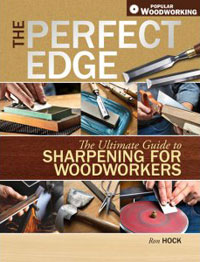
BOOK REVIEW:
The Perfect Edge, by Ron Hock
by J. Norman Reid
Delaplane, VA
Ron Hock is, justifiably, a blade maker of renown. In this book,
The Perfect Edge
, he
has given us a perfect introduction to the practice of sharpening the tools we
woodworkers regularly employ. This well-crafted, clearly-written and sometimes
humorous book answers many of the vexing questions woodworkers ask.
Hock opens with the question, "why sharpen"? The answer, as he states, may seem
obvious–"sharp tools are better tools." More important is his conclusion that "the small
investment in time spent sharpening your tools makes a huge difference in how they
perform." For Hock, that is what sharpening is all about.
One of the most important chapters follows, answering "what is steel"? Given the
different types of steels used in woodworking tools, it is important to understand the
differences and what they mean for performance–for durability and ease of sharpening,
in particular. Look here for clear explanations of oil hardened, air hardened and high-speed steels, among other types. Additionally, Hock explains heat treatment and even
provides guidelines so do-it-yourselfers can heat treat their own tools. A final topic in
this chapter is his discussion of steel's arch enemy, rust, and how it can be prevented
and removed.
Confused by the variety of abrasives in the marketplace? Understand the differences in
sandpaper? In other abrasives? In Chapter 3 Hock thoroughly describes abrasive types,
including sandpaper, diamond plates, strops and stones. A valuable chart comparing
grit sizes for various sharpening media appears on page 50 and will answer the
questions of woodworkers who wonder, for example, how a hard Arkansas stone compares with a waterstone. Likewise, page 56 demystifies the differences in types of
grinding wheels.
Chapter 4 takes a look at the edges we put on our tools and how they work to cut wood
effectively. This clearly illustrated discussion is an important one for
understanding the way blades interact with wood and why they are sharpened the way
they are.
The following chapter, "The Fundamentals," first examines bevel angles, including
microbevels and back bevels. If you wonder whether you can have too much of a
microbevel on your plane or chisel blades, this chapter will provide an answer.
Chapter 5 also gives some valuable advice: keep your stones flat, keep them wet with
water or oil, keep the surfaces clean, keep your tools cool, keep practicing (you'll get
better as you do), and test your edges. Do waterstone users need a
Nagura Stone
to
create a slurry on their finest stone? Hock answers this on page 73.
A major part of this chapter is a review of
sharpening devices
. Included are honing
guides, sharpening kits, grinders, belt sanders, vertical grinders such as the
Tormek T-7
and horizontal grinders like the
Worksharp WS 3000
. Hock reviews specific brands for
each type of device and assesses their usefulness for sharpening. While he leaves the
ultimate choice to the reader, his advice will be valuable in selecting among alternatives.
The section concludes with some pointers for setting up a basic sharpening kit,
including the option of adopting the scary sharp system.
The remainder of the book is a series of chapters on individual tools and how they can
best be sharpened. He begins with plane irons, first answering the question of why to
establish a back bevel. Because plane irons occupy much of our attention as
woodworkers, Hock goes into detail on bevel-down and bevel-up blades, the sharpening
process, freehand honing, cambering, polishing and stropping, tapping out a Japanese
plane blade, and treating the chip breaker, among other topics.
Succeeding chapters address spokeshaves, chisels, scrapers–and how to turn a
burr–and scraper planes, handsaws, carving tools, drawknives, turning tools, axes and
adzes, knives, marking gauges, scissors and drill bits. Though his focus is mainly on
hand tool sharpening, he also discusses sharpening router and shaper cutters and
chainsaws.
The book concludes with an interesting, if inconclusive, chapter on microscopy that
includes magnified photos of edges sharpened with different media.
This book stands out for its clear descriptions, good illustrations and step-by-step
instructions. A particular strong point is Hock's comparison of tool alternatives and what
to expect from them. He does not shy away from offering his opinions about the
relative merits of specific brands.
A few new developments, such as the new Veritas PM V-11 tool steel and
Benchcrafted's Galbert Drawsharp
for drawknives are not included in the book, having
been released after the book was published. But this hardly blunts the value of this
book, whose advice is, in general, timeless.
This book is an excellent resource for any woodworker who needs to sharpen his or her
tools–and that includes all of us who use hand tools in our shops. Any woodworker who
wants to understand better the types of steel and what they mean in the woodshop, any
woodworker who wants a clear understanding of sharpness, any woodworker who has
questions about grits (the kind you sharpen with, that is!) and any woodworker who is
seeking to purchase sharpening equipment will benefit greatly from this book.
CLICK HERE to order your copy of
The Perfect Edge
The reviewer is a woodworker, writer, and woodworking instructor living with his wife in the foothills of the Blue Ridge Mountains with a woodshop full of power and hand tools and four cats who believe they are cabinetmaker's assistants.
He can be reached by email at
nreid@fcc.net
.
Return to
Wood News
front page


